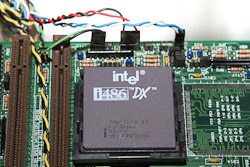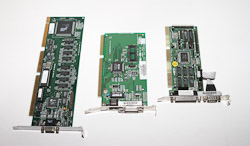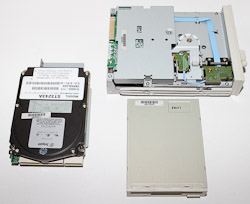How much Gold is in a Computer? $9 worth
We take apart an old desktop computer to show what is valuable
EScrap such as whole computers or individual components from computers contain gold, palladium and other precious materials. Computer circuit boards have gold and other precious metal traces in densities comparable to mined ore. There is enough valuable material to make refinement profitable on even a moderate scale.
Why are there precious metals in EScrap?
Gold is the 2nd best conductor of electricity, it is the most malleable metal, it can be made into micron-thin leaf and it is highly resistant to tarnish. These characteristics made gold well suited for circuit boards. Gold is frequently used as connectors ("Fingers"), and sometimes used as the PBC traces and components pins (in high performance boards).
Many circuit boards have small amounts of Silver and Palladium in their solder and components (e.g. transistors.)
Taking Apart the Computer
Let's examine the many components of a typical PC. All computers have these same set of components. A $ denotes a value rich component.
- Case - A heavy, metal and plastic enclosure.
- Power Supply - A heavy metal box inside that provides power to each component
- Motherboard ($) - the main, large circuit board that all other components are connected to
- Hard Drive - Smaller metal box that is the storage drive for the PC
- Disk drives - drives for Floppy, CD, DVD and other media
- PCI boards ($)- boards connected to the motherboard to provide additional functionality such as graphics output.
- RAM ($) - slim circuit board sticks that provide memory for the machine.
- Processor ($) - square, many-pinned components that is the 'brain' of the PC
- Connective wires - cables that connect all the above together.
The Case
Computer cases hold the PC together and are made from steel and plastic. They add most of the bulk and none of the value (steel is worth mere pennies a pound). The case can make it unprofitable to recycle small lots of PC's, as the case's mass and volume drive up the shipping costs.
If you have a small number of PCs, the best approach is to disassemble them and sell us the individual components. The cases can be sold to a local scrap yard and recycled.
If you have a large number of PCs (more than 1000lbs), shipping becomes economical. We can arrange for a truck to pick up the whole computers and bring them to our facility for disassembly. We pay more for disassembled computers, as shipping and labor expenses are far lower for PC components.
Power Supply
The power supply provides regulated, DC power to all the PC's components. It is a large metal box with a number of color-coded wires connecting it to the other components in the PC. The power supply is heavy due to the iron core in the transformer within it. As a result, it has very little value and it is bulky and heavy. Like the case, the power supply diminishes the profitablity of PC recycling.
Motherboard
The motherboard is the large circuit board that connects the innards of the PC together. All the components communicate with each other through the motherboard. The Motherboard is rich in value and has several of the most valuable parts of the PC attached to it.
The board itself has many gold plated connectors and pins. Older and high end motherboards (such as those found in rack servers, telecommunications equipment, or military test equipment), often have gold in the traces and components. Motherboards are one of the most value-dense portions of the PC.
Attached to the motherboard are the processor and RAM. These contain precious metals as well. Warning: Motherboards typically have a battery on them - it should not be thrown out. Batteries contain toxic materials and need to be recycled. Batteries should be removed prior to shipping; they can be sent to us for recycling.
We buy Motherboards for about $3.20 a pound.
Processor
The processor is the brain of the PC. It contains millions to billions of microscopic transistors and a few hundred gold plated pins. Processors are one of the most value dense portions of the PC. Older processors are generally larger and have more generous gold plating than more modern ones. 386/486 and Pentium chips are particularly valuable. More 486 processor details.
The processor is recognizable as a large rectangular or square chip that plugs directly into the motherboard. It is usually the largest single chip in the PC. The processor often has heat sink attached to it which may also have a small fan. Heat sinks are typically aluminum, which has little scrap value.
We Buy Processors from $8 to $95 per pound.
RAM
RAM, or Random Access Memory, is the short-term memory of a computer. RAM chips are found as a bank of long, rectangular 'mini circuit boards' that are populated with numerous memory modules. A computer may have 1 to 8 RAM modules. Older RAM modules are generally smaller, but have bulkier chips. Newer modules are recognizably sleeker. In contrast to processors, we are sometimes able to pay more for newer RAM chips.
RAM modules are small, light, but valuable. It is very economical to ship and process RAM.
We usually buy RAM for $8 a pound
PCI boards
PCI Boards found inside this Computer. From left to right: VGA Graphics card, Dial-up Modem, Peripherial expansion board (e.g. for a printer)
To extend the base functionality of a PC, additional circuit boards are typically added via the Peripheral Computer Interface. These boards typically add network connectivity such as through a modem or thernet connection, additional drive ports through a SCSI or IDE connection, dedicated video hardware through a video card, and many others.
These boards are valuable due to precious metals found in their components as well as the connector pins and traces. They are generally fairly compact and light.
PCI cards are usually worth $3.20 a pound. (this value is less if the steel brackets are included)
Drives
Disc Drives found inside this Computer. Clockwise, starting from left: Harddrive, 5.25" Floppy Drive, 3.5: Floppy Drive
Storage drives enable data to be saved, transferred and read from the computer. Over the years, smaller and more sophisticated drivers have been developed. 5.25" and 3.5" floppy disk drives were some of the first, followed by ZIP, CD, DVD, and now Blu-ray drives. These drives, especially the older, bulkier ones, are not very value dense. They are primarily casing and motors with only a small amount of precious metal containing circuit boards.
Every computer also has one or more hard drives (HDDs) which function as the long term memory for the PC. These drives do have some controler circuit boards inside of them which have some value. They are also generally more compact than the disc drives.
Connective Wires
All these components are brought together by various interface cables such as ribbon cables with numerous separate wires, power cables which are typically bundles of 4 wires (and originating from the power supply), small control wires leading to LEDs and switches and eSATA cables in more modern machines.
These cables and wires are comprised of rubber coated copper stands. Copper is a fairly valuable metal (far, far less valuable than gold or platinum, but far more than steel and aluminum), so wires can be economically recycled for profit.
We Buy Scrap Computers and their components
We buy computer components and whole computers and pay you for the precious metals (such as gold, platinum, silver, and palladium) found inside them. Check out what comptuer scrap we purchase.

Contact Us
To learn more about refining your scrap
Shipping
Ship your scrap for analysis or refinement
Got a lot of Scrap?
Our commercial services can help make refining 10,000lbs of scrap a breeze.










